As a result, the collector is at once on firmer ground. His knowledge of earlier periods had been gleaned6 haphazard7 from drawings, paintings, tapestries8, mosaics9, and historical documents, with only here and there a specimen10, and that of dubious11 authenticity13, to guide him. From this{56} time he is able to observe at first hand, compare, classify, note differences, excellences14, and defects. There is no longer any lack of material, either of the finer sort suitable for the tables of the great and wealthy, or of the coarser kind whose only merit was utility.
With the growing profusion15, however, came a veritable confusion of types, which renders any attempt at classification a matter of very considerable difficulty. To a great extent this arose from the toping habits of our forefathers17 in perhaps the most convivial18 period of our history. There was a vast improvement in social conditions and amenities19, and the variety of glasses that sprang into existence affords ample testimony20 to this, as well as to the variety of drinks in favour and to the ingenuity21 of the times in devising toasts and sentiments, no less than to the skill of the English craftsmen and the individuality of the various makers22.
At the beginning of the century, however, the use of different glasses for different kinds of wine had not yet arisen. A bowl of water was placed on the table in which the drinkers rinsed23 their glasses when a new vintage made its appearance. Subsequently each guest had{57}
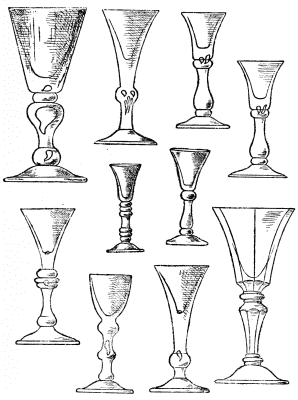
Fig24. 40.
Examples of Baluster Stems and Tear Glasses.
his special bowl for this purpose. These bowls are exceedingly rare, and are generally described as wine-coolers. Their modern equivalent is the finger bowl.
There was naturally a vast difference between the glass of the early part of the century and that of the later part. Speaking very broadly, the order of progress was as follows:—
1. Heavy glass with baluster stems.
2. Lighter25 glass with air-twisted stems.
3. Drawn26 stems.
4. Opaque27-twisted stems.
5. Cut glass.
Many of these glasses are still in existence and it is even possible for the amateur collector to acquire an occasional specimen. This early eighteenth-century glass is of remarkable28 quality, both as regards form and lustre29. It is true that it is less perfect in shape and texture30 than the products of to-day, but it is superior in artistic31 merit, in originality32 of design and softness of outline. The lack of perfect symmetry is one of its charms, as it is in the case of old lace which, so far as absolute and meticulous33 perfection of detail is concerned, is often far behind the modern machine-made product. But what it{59} lacks in symmetry and precision is more than compensated34 by artistic feeling.
Mr Hartshorne in his monumental work on “Old English Glasses,” a work to which the present writer and every other writer on the subject must acknowledge a vast indebtedness, makes an exhaustive classification of the various types of eighteenth-century glasses. To his order one is bound closely to conform, although it is far from the province of the present work to attempt to deal exhaustively with the various types he so fully35 and admirably describes.
The earliest examples have funnel-shaped bowls with tall stems. These are of great variety of shape. Some are quite plain, others are twisted, others ribbed. Some, again, are “baluster” shaped, i.e. formed after the pattern of the columns of a balustrade. Many have a knop or button in the middle, others are ornamented36 with twisted lines, either hollow or filled with glass of different colours, interwoven in spirals, twists, networks and plaits in all kinds of ingenious ways.
Of course, all these things being distinctive37 are imitable, and here the peril38 of the collector begins. The expert is rarely deceived as to{60} whether any specimen is genuine old glass; but so pervasive39 and so perfect are the imitations that exist, and so plausible40 the conditions under which they are found, that it behoves the amateur to use the extremest caution. I propose to deal at some length with some of the more obvious and frequent frauds and fakes in a subsequent chapter. But for the moment it may be said that the best test of genuineness is neither shape nor any particular design—for these can be closely imitated—but the colour. There is a curious tint41 in old glass which the new never quite achieves. The would-be small collector will be well advised if, before riding his hobby, he goes through a brief course of eye-training under the guidance of an expert, until he gets the exact tone of the old glass firmly impressed upon his memory. As an additional factor, it should always be borne in mind that the old glass is invariably heavier than its modern imitation.
It will be desirable at this point to describe in brief detail the more important of the types of eighteenth-century glass enumerated42 on page 59.
Glasses with Incised and Ribbon-twisted Stems.—The incised or ribbon-twisted stemmed glass{61}
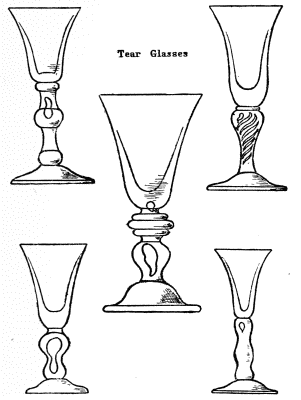
Fig. 41.
as shown in Fig. 36, is usually about 6 inches high with, generally, a flanged43 or outward curved top and a comparatively slender stem. A series of ribs44 was impressed by a mould on the stem whilst yet plastic. The stem was fixed45 to its bowl, heated till soft, and then gently twisted and, at the same time, stretched. The result was a twist, produced in exactly the same way as in a stick of candy—close at the top and gradually loosening toward the bottom. Near the foot, by the way, the spiral generally disappears entirely46 as the effect of the heating process necessary when the foot was joined to the stem. The bowl was almost invariably waisted, that is, its sides were bent47 inwards. The foot was folded and there was a characteristic lessening48 in the diameter of the stem as it neared the bottom, which the “puller” of toffee will readily understand.
Air-twisted Stems.—The air-twist probably began with a “tear.” The tear of the glass-blower is a bubble of air blown into the centre of a mass of molten glass, possibly at first by accident and afterwards by design, as a form of ornamentation. When the stem was
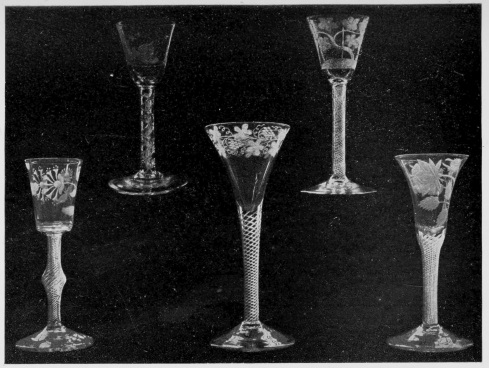
FIG. 7—AIR-TWIST STEMS.
(From the Rees Price Collection, by permission of the Connoisseur49).
drawn out, the bubble elongated50 into a tube, and when the stem was twisted, the tube acquired a spiral shape. Now as the tube was filled with air, which had a different refractive capacity to the glass which surrounded it, the effect of the light falling upon it was to produce a kind of silvery radiance like that of quicksilver. The phenomenon is familiar to anyone who has ever plunged51 a substance like wool, which contains air-bubbles entangled52 among its meshes53, under water. The bubbles are transformed into drops like quicksilver. So with the tear and the tube drawn from it in the air-twisted stem. Naturally the decorative54 potentialities of this phenomenon were speedily recognised and utilised, and the air-twisted stems are among the most characteristic and the most beautiful features of all old English glasses.
The bowls were usually of the same general shape as those with incised and ribbon-twisted stems. The earlier varieties are “waisted,” the later ones frequently assume the bell shape. They are often engraved55, the early ones with the Tudor rose, with its five petals56, while the later ones affect the{64} Stuart variety with six petals. The earliest stems have necks and collars—there was considerable difficulty in joining the air-twisted stem on to the bowl without damaging the twist. Later varieties have necks only. The collars are sometimes knopped, i.e. have knobs attached, and the stems themselves are shouldered.
I have dealt at some length with the air-twisted stems, since this is a characteristic English variety, and one to which the brilliant English flint glass was specially57 adapted. Consequently the type persisted for a considerable period. The later varieties, however, achieve some little distinction by the adoption58 of the bell-shaped bowl.
Drawn Stems.—I have already suggested that the fusion16 of the air-twisted stem, in order to join it to the bowl, not unfrequently resulted in damage to the twist. It was an obvious solution of the difficulty to draw the stem out from the surplus molten metal at the base of the bowl. If, previously59, a series of air-bubbles was introduced into this mass, each in the process of drawing out became elongated into a tube, and we have the possibility, by planting “tears” in effective positions, and then{65}
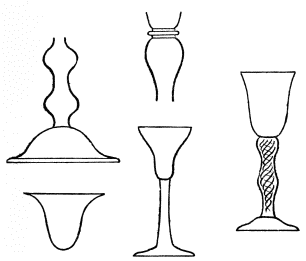
Fig. 42.
The figures given above illustrate60 certain of the characteristic features of Old English glasses. Thus Fig. 1 is an example of a double-knopped stem, each of the bulges62 being technically63 known as a “knop.” The foot is “domed64.” No. 2 is an illustration of a shoulder and collar, the shoulder being the bulge61 near the top, and the collar the ring above it, which was originally devised to hide any clumsiness in joining the stem to the bowl. No. 3 is a “flanged” bowl, No. 4 a “waisted” bowl, and No. 5 shows an air-twisted stem.
judiciously65 twisting the drawn stem whilst still plastic, of producing an infinity66 of pleasing patterns. Thus a number of small “tears” close together produced a spiral like a yarn67 of silk; or a central tear might be blown, and side ones twisted round in encircling spirals.
Baluster-stemmed Glasses.—The baluster stem is a reproduction of a moulded pillar. It is by no means peculiar68 to eighteenth-century glasses. Indeed it formed the almost invariable means of support for the glasses of Caroline times. The early baluster stems are, to an eye accustomed to the lighter modern glass, extremely heavy and clumsy in appearance, and with the development of taste and skill, they were speedily supplanted69 by the slenderer and more graceful70 drawn and air-twisted stems. But the effect of the baluster moulding was soon pressed into the service of this more dainty ware71, the baluster becoming more slender and symmetrical, and sometimes, indeed, being modified into a slight swelling—either gradual or abrupt72 or a single ring round the stem. The bowls of this period were almost invariably funnel-shaped, and were often engraved—the appropriate figure of the vine leaf appearing for the first time in the{67}
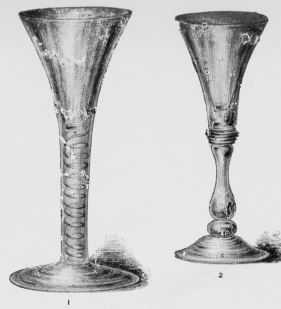
1. AIR-TWISTED STEM GLASS.
2. BUTTON STEM.
3. BALUSTER STEM WITH ROYAL MONOGRAM73.
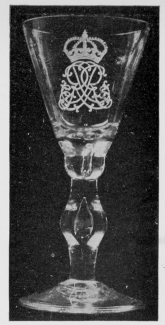
(From the Rees Price Collection, by permission of the Connoisseur.)
FIG. 8.
history of English glass. The feet are almost always of the folded variety. Occasionally, in the later specimens74, however, the feet are domed.
Opaque-twisted Stems.—The opaque-twisted stem made its appearance about the middle of the century. In this case, rods of opaque white or coloured glass were alternated with rods of clear glass around the circumference75 of a circular mould, care being taken to preserve proper regularity76.
They were then heated, and molten clear glass poured into the central hollow, filling up the interstices between the rods, binding77 the whole when cooled into a solid rod, with a clear centre surrounded by a particoloured circumference. The mass, being softened78 by heating, was then drawn out into slenderer rods, and twisted into spirals.
The ease of the process accounts for the infinite variety of patterns in existence. Flat bars could be used, giving tape-like spiral bands, and the rods could be of various sizes and colours. Many specimens came over from Holland and from the north of France, generally of inferior quality, the inferiority{68} being displayed in the character of the stems and the poorness of the metal.
The simplicity79 of the manufacture has also given rise to hosts of modern imitations, largely from the Continent. In a great number of these the spirals turn to the left, which has given rise to an idea that all glasses with right-handed opaque spiral stems are modern imitations, which is by no means the case. All such specimens, however, are sufficiently80 suspect to demand careful scrutiny81, and the amateur, before purchasing a right-handed spiral opaque-twisted glass, will do well to submit it to the judgment82 of an expert.
Points to be considered are the colour of the metal, the perfection of the twist, its opacity83, and the character of the foot. The colour and weight of the glass are probably the best criteria84. The forgeries85 are generally light, and the beautiful mellow86 tone of the real old English glass is replaced by a cold white tint or even a tinge87 of green. The twist is often more translucent88 than in the genuine pieces, and is frequently imperfectly produced, becoming looser as it descends90, the loosening being particularly pronounced just before its junction91 with the foot.
The appearance of the foot is of the utmost{69}
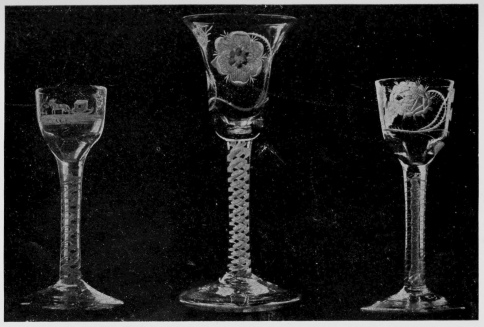
FIG. 9.—OPAQUE TWIST STEMS AND “ROSE” GLASSES.
(From the Rees Price Collection, by permission of the Connoisseur.)
value. Before the nineteenth century the scar, where the piece after manufacture was broken away from the pontil, was invariably left rough, instead of being ground down. The foot in the genuine glasses is never flat, there being always a slight slope downwards92 towards the edge. In the imitations, too, it is apt to be less in diameter, compared with the bowl, than in the genuine specimens, whilst there is frequently an absence of “ring.” This last fact, however, must not be unduly93 emphasised, since many undoubtedly95 authentic12 specimens of this period, including some of the finest, share the defect. Another test is to note the edge of the bowl, whether it is well rounded off or whether it has been left hard and sharp.
Many of these glasses are engraved with flowers. The rose is so frequent as to give its name to a special type, the “rose glasses.” The rose has often a bud or two, and a butterfly is frequently represented as hovering96 over the flower. In later specimens the butterfly degenerates97 into a moth98, and finally vanishes altogether. Other flowers engraved on glasses of the same type and period were the Rose of Sharon and the St John’s Wort. Rose glasses,{70} with blue and white twisted stems, are in all probability almost exclusively of English manufacture, and are among the most valuable of the opaque-twisted type. The foreign importations of the period were numerous but, apart from certain patterns of twist, which may be considered exclusively English, the twisting of the Low Countries was distinctly inferior. One type is characteristic of the foreign product. This has a central tube of thin white lines, surrounded by spiral twists. Where the stem is of the baluster type, this central tube, more or less, follows the contour of the stem.
Straight-sided Glasses.—The term “straight-sided” may be used to designate a whole series of glasses, of which the bowls are of the shape of a truncated99 cone100, the narrow end being, of course, downward. In process of time the sharpness of the section at the bottom was more and more rounded until it attained101 the shape of the ogee curve. The earliest of the straight-sided glasses had bulbed stems, with a shoulder and knop. The better sorts of tavern102 and household glasses were of this type, the larger specimens being used for wine and punch and the smaller for cordials and strong waters.{71} Two points are worthy103 of notice: the folded foot was practically invariable, and the diameter of the foot was always substantially greater than that of the bowl, thus ensuring a sound support.
The bowls themselves were at first plain. About the middle of the century, however, we find them decorated with conventional flowers and vine leaves, etc., which were gradually replaced by closer and more artistic representations of such natural objects as roses, as a matter of course, lilies of the valley, tulips, and sprays of honeysuckle. Amongst these, however, certain conventional designs held their place, e.g. wild roses, St John’s Wort, and other blossoms with large seeded centres, which seem to have impressed themselves strongly upon the imagination of the artists to whom the decoration was entrusted104. The bowls were, in very rare instances, fluted106.
The pieces were made in three parts—bowl, stem, and foot—the stem being sometimes plain, oftener air-twisted, and sometimes opaque-twisted. The straight-sided bowl was never popular amongst Continental107 glass-workers, so that the probability is that any specimen found is of English manufacture. In examples of{72} foreign manufacture, too, the bowl was generally rounded at the base, and the stems were often coloured or opaque-twisted. Other characteristics by which these may be identified are their comparative lightness of weight, their fragility, their coarse lavishness108 of decoration, their narrow bases, while the twisting of the stems is often unduly close, and the bowls have wide, flat flutes110.
Ogee Glasses.—The straight-sided glasses changed by easy degrees into the well-known ogee shape, the lines of the bowl being gradually merged111 into those of the stem. It may be safely asserted that the majority of ogee-shaped glasses are of English manufacture. The majority have opaque-twisted stems; sometimes blue lines replace the opaque white. It is thought that Bristol was the chief place of manufacture, since most of the finds have been in the west of England. The earliest of them have unfolded feet, inserted air-twisted stems, and naturally, since the object of the designer was to preserve the ogee line, no shoulders. Many of them are of considerable dimensions—a possible result of the custom of drinking bumpers112. A great number of the memorial glasses, treated of in a separate chapter, were of this type. The{73}
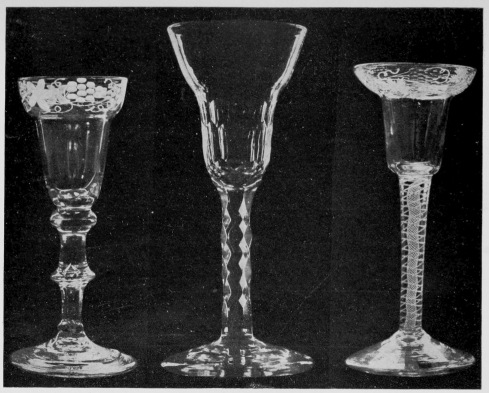
FIG. 10.—DOUBLE OGEE BOWLS.
(From the Rees Price Collection, by permission of the Connoisseur.)
scheme of decoration followed much the same lines as that of the straight-sided glasses, but a greater proportion were plain; possibly the curves toward the bottom of the bowl made the engraver’s task more difficult. In the later specimens, sprigs of laurel and festoons of various conventional types are to be found. In the Bristol glasses the bowls were sometimes fluted, and a double ogee curve was employed, the upper part only being decorated, generally with vine leaves and bunches of grapes. The stems were bulbed or knopped, and the feet were folded.
Champagne113 Glasses.—There is, of course, no real reason why one kind of wine should be drunk from a glass of special shape and another from a totally different one, but once glass drinking vessels had become the vogue114, this habit of specialising in the shape and size of glasses speedily became the fashion and crystallised into a custom which persists even to-day in our port, sherry, champagne, claret, and liqueur glasses. In the beginning there was a far greater diversity, for England in the eighteenth century was famous for the number (and potency) of its beverages115 and, speaking{74} generally, each had its appropriate glass. Frequently, of course, there was little diversity of shape, the difference being in the nature of the ornamentation, which in a number of cases was specially devised to indicate the purpose of the glass. Thus an ale glass would be adorned116 with ears of barley118 or bunches of hops119; a wine glass with vine leaves or bunches of grapes; a cider glass with sprays of apple blossom, and so forth120.
Champagne was, in the eighteenth century, a wine of comparatively recent introduction, and was drunk only by the rich and great. Probably at first no special glasses were used for it, the more elegant of those already in existence, presumably bell-shaped and air-stemmed, being pressed into the service, but about 1730 special glasses were made, with wide, shallow bowls, of the double-ogee variety and a baluster. They had knopped or double-knopped stems and domed feet. Sometimes, as might be anticipated, an air or opaque-twisted stem was employed, while the shape of the bowl varied121 towards the bell shape, in that it became hemispherical.
Subsequently the bowl became elongated into{75}
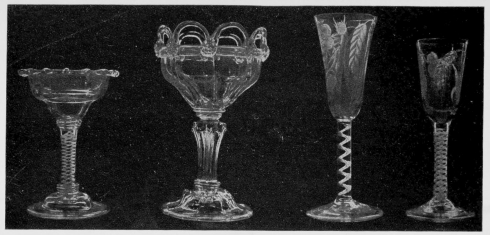
FIG. 11.—SWEETMEAT GLASSES. ALE GLASSES.
(From the Rees Price Collection, by permission of the Connoisseur.)
a narrow cone, the stems exemplifying the various patterns of the day—baluster, knopped, double-knopped, air-twisted, opaque-twisted, and drawn. In the later examples the elongation was so pronounced that the glasses approximated to the familiar flute105 shape. In these the stem is often faceted122, the facets123 sometimes extending some considerable distance up the glass. The modern champagne glass, with a wide saucer-like bowl and a hollow stem, seems to be a sort of combination of the two. The wine being a rarity, the glasses are scarce, and the collector who unearths124 a genuine specimen of an early eighteenth-century champagne glass may esteem125 himself fortunate.
The shallow glasses were so little known that a hundred years later, in 1832, Disraeli, writing to his sister, remarks: “We drank champagne out of a saucer of glass mounted on a pedestal of cut glass,” so that the form was evidently a novelty, at least to him.
Sweetmeat Glasses.—Closely allied126 to the shallow champagne glasses were the sweetmeat glasses. The latter are, however, much solider, while their edges are crinkled and undulated and vandyked into various patterns. The feet{76} are generally domed, sometimes plain, and at other times ribbed or ornamented with knobs. The bowls are generally either of the double-ogee type or bell-shaped with a lip. They are often ribbed in the earlier varieties, and cut in the later ones. The glasses were made in sets, which stood upon a glass pedestal or centre-piece made to a similar pattern. This had a flat, tray-like top, with a raised rim127. One interesting feature is that each set consisted of a number of small glasses and one large one, known as a “Captain” or “Master” glass, which was not necessarily of the same pattern as the smaller ones. The Captain had generally an abnormally small foot, so that it might not unduly encroach upon the standing128 space.
Ale and Beer Glasses.—There is no particular difference between the tall champagne glass and the ale glass; possibly the ale glass was modelled upon the flute-shaped champagne glass, or possibly the shapes were used indiscriminately for both beverages—the finer and more elegant specimens for the champagne, and the heavier and more substantial ones for the humbler ale. That they were so used is sufficiently indicated by the fact that many{77}
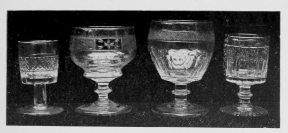
SPECIMEN OF IRISH DRINKING GLASSES, SHEWING VARIETY IN CUTTINGS. 18th-19th CENTURY.
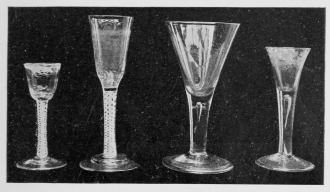
ENGLISH DRINKING GLASSES. 18th CENTURY.
1. A CORDIAL GLASS WITH AIR-TWISTED STEM.
2. A BARLEY WATER GLASS WITH OPAL-TWISTED STEM.
3. AN OLD “TEAR” GLASS.
4. A STRONG WATER CORDIAL GLASS WITH “TEAR” IN STEM.
FIG. 12.
specimens have been discovered which are engraved with festoons or bunches of hops and ears of barley. The earlier specimens, however, were plain. It may be useful to point out that the form of the stem affords some indication of the relative age of the piece, the chronological129 order being roughly as follows:—(1) Waisted bowls, with plain stems and folded feet; (2) air-twisted stems, shouldered, collared, and knopped; (3) plain drawn stems; (4) opaque-twisted stems. The glasses diminish in height as the century progresses.
Other Kinds of Glasses.—It is customary to include in the classification of eighteenth-century glasses those used for cider and perry, mumm, mead130, and syllabub. It is difficult to prove that any particular kind of glass was set apart for the consumption of these liquors. Cider, however, was produced in large quantities, and glasses were possibly made specially for it. Certain specimens exist, and are recognised by their being engraved with apple blossom, apple trees, etc., whilst one—mentioned in the chapter on Memorial Glasses—is inscribed131 with the motto “No Excise132.” Speaking generally, it may be asserted that ordinary{78} cider was probably drunk from earthenware133 mugs, after the fashion of the beer mugs of to-day, whilst the strong cider was consumed from wine glasses. No glass has so far been distinctively134 associated with perry.
Mumm was a somewhat awesome135 decoction, in which the principal ingredient was malted wheat, to which were added a little oats or bean-meal, the brew136 being flavoured with various pungent137 and aromatic138 herbs and the inner bark and tips of the fir tree. It is presumed to have been drunk from glasses of the ale-champagne type, but among the common folk it is probable mugs were preferred.
“The clamorous139 crowd is hush’d with mugs of mum
Till all, tun’d equal, send a general hum.”—Pope.
Mead (or meath) was a drink the basis of which was honey. This, being dissolved in boiling water, was flavoured with spices and ground malt added, and the whole left to ferment140. It was drunk from bowl-shaped glasses, or else from glasses of the low tumbler type. If carefully made it would keep for a long time, and from the number of references to it which appear in literature, it was evidently a favourite drink,{79} particularly among the lower classes. Ben Jonson in his “The Devil is an Ass,” written in 1616, remarks:
“ ...Carmen
Are got into their yellow starch141, and chimney-sweepers
To their tobacco and strong waters—Hum,
Meath and Obarni.”
Syllabub was a mixture of wine, ale, or cider, with cream or milk, and flavoured with lemon or rose-water. The whipped syllabubs were beaten into a froth before drinking. They were often made with milk drawn fresh from the cow, the drinkers repairing to the dairy for the purpose.
“Your ale-berries, caudles and possets each one,
And sillabubs made at the milking pail,
Although they be many, beer comes not in any,
But all are composed with a pot of good ale.”
Syllabub glasses, as far as there were special glasses used, were of deep cup or tumbler shape, the brim flaring142 outward.
Cordial and Strong Waters Glasses.—The art of distillation143 came from Arabia, as the name alcohol (al Kohl) indicates. Northern peoples, however, for a long time preferred, to the distilled144 products, cordial waters made from honey,{80} fruit syrups145, spices, and various herbs. Each notable housewife had her own recipes for cordials, and many and quaint146 were the products that came from the family still-room. It was not, indeed, until comparatively recent times that the habit of spirit-drinking made any great headway in England. Whisky was made in Ireland in the fourteenth century, and must consequently have been known in England. Howell in his “Letters” refers to the usquebaugh of Ireland, but remarks that “whereas in England they drink it in aqua vit? glasses, in Ireland they drink it in beer glasses.” The quotation147 proves that even at that early period special glasses for spirits were in use. Greene, some thirty years later, includes among the glasses he ordered from Venice small glasses marked for brandj.
The taste was probably intensified148 after the Revolution of 1688 brought numbers of Dutchmen into the country. The glasses employed were, generally speaking, miniature replicas149 of the wine glasses in vogue; others are short-stemmed, and as this did not lend itself to air-twisting, the baluster type was mostly affected150, which in such small glasses gives a peculiarly{81} massive appearance. Opaque-twisted stems are, however, more frequently met with, as are fluted ones. Sometimes the bowls are fluted or faceted. The dumpy, thick-stemmed, wide-bowled cordial glasses are often termed “Hogarth” glasses, they being the prevailing151 type in his pictures.
The modern equivalents are the “firing” glasses used at Masonic banquets, the members after each toast knocking the glasses in unison152 on the table—the sound produced being fancifully likened to the reports of guns. Figs153. 1 and 2 (p. 160) are illustrations of firing glasses, the former being antique and the latter modern and strictly154 utilitarian155.
Not all cordial and strong waters glasses belong to this type. Some of the most valuable have long stems, either plain or opaque-twisted. Many of the latter, however, came from the Netherlands and stand outside the category of English glasses.
The “thistle” glass has come to be the recognised Scottish liqueur glass. The form originated, it is believed, in Bohemia, but once it had made its way here, it was natural that the Scots should take for their national liquor{82} the glass that bore the form of their national emblem156. At any rate the beginning of the Scottish glass industry was marked by the production of a thistle glass, which was made at the factories in Edinburgh.
Tavern and Household Glasses.—It is customary to refer to tavern and household glass as belonging to a separate classification. There is really no justification157 for any such division; it is perfectly89 natural that utensils158 for common use should be stronger and clumsier editions of the better-class glasses. The very earliest were clumsy in the extreme as regards design, and rough in execution, but later specimens show greater elaboration and skill.
With the advent159 of the drawn glass, most tavern and household glasses took this form, and have retained it with little variation. Two kinds are noticeable—those with a “blow” inside the stem, and those without. In the drawn stems the blow shrank in dimensions, and became a tear, which, by the way, is almost invariably upside down, the broader end being uppermost. Half-way through the eighteenth century the tear vanished altogether, and the plain solid stem came into use. The common wine glasses were{83} small editions of the larger glasses, and frequently bore rudely executed decorations of festoons, vine leaves, and flowers. The feet are flat, and may be either folded or unfolded, the former being of the earlier type. Specimens are fairly easily obtainable, the thickness of the metal and the stoutness160 of the design carrying them safely through the dangers to which they were specially liable. Apart from their age they have no special merit. The metal is as inferior as the form.
Tumblers were less frequently made in the eighteenth century than were wine glasses, and in the early part, at any rate, those that were met with were chiefly foreign importations. It is possible that the plain lines of the tumbler did not appeal to tastes accustomed to the graceful outlines of the wine glasses. The early ones are cylinder-shaped, and very large, while eighteenth-century tumblers taper161 somewhat toward the base. Both are very scarce. Now and again one meets the barrel shape. Foreign tumblers are often profusely162 decorated by engraving163, colouring, and gilding—the quality of the decoration being distinctly inferior to its quantity.
The rummer is a characteristic Old English public-house glass, and is of various types. It was, of course, as the name implies, used for making punch. Among the types are the ogee-shaped bowls—either plain or pressed—barrel-shaped bowls, and trumpet-shaped bowls. All have short, thick stems, often with a collar, sometimes baluster-shaped. The base is strong and generally flat. Some specimens have heavy, square bases, evidently designed to secure their stability.
Cut Glass.—The introduction of the so-called flint glass—which was, in effect, glass containing a greater quantity of lead than had previously been used—created something of a revolution in the art of English glass manufacture. M. Peligot, a leading French authority, remarks: “To the English should really be attributed the honour of having created, in their flint glass, a new product which by the quality and selection of the materials used in its fabrication has become without doubt the most beautiful glassy substance which we know and which, in my opinion, it may be possible to produce.” But in addition to the beauty of the metal was the fact that it had a greater refractive and dispersive164 action on
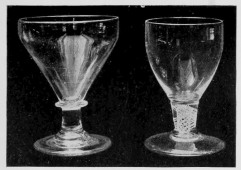
ENGLISH “RUMMER” AND DRINKING GLASSES. 18th CENTURY.
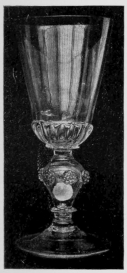
A BALLUSTER STEM GLASS SHEWING A COIN BLOWN IN THE STEM.
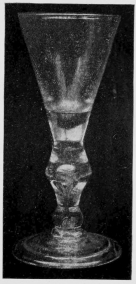
EARLY ENGLISH BALLUSTER STEM GLASS.
FIG. 13.
rays of light than any other kind of glass, and consequently lent itself specially to cutting—the workmanship bringing out the beauty and brilliancy of the metal, and the quality of the metal enhancing the effect of the cutting.
It is difficult to fix, with any degree of precision, the date at which glass was first cut by way of ornamentation. There are certainly traces of its employment towards the end of the seventeenth century. At the beginning the craftsmen of Bohemia were probably far superior to those of England, but as soon as the special suitability of the English glass was demonstrated, the native workmen speedily outdid all foreign competitors. The quality of the glass and of the cutting gradually improved, until at the close of the eighteenth century practically all English glass of any importance was ornamented in this fashion, and the English product was famous all over the Continent.
In this way the beauty and value of a piece speedily came to depend upon the amount and the depth of the cutting: the more deeply and profusely it was incised the greater its artistic merit was assumed to be and the more highly it was esteemed165. In certain instances,{86} undoubtedly, the art was carried to excess; hence those monstrosities of the Early Victorian period—clumsy masses of flint glass cut into hob-nails, facets, pyramids, and spikes166 of all shapes and dimensions. Of this description are the massive glass chandeliers which depend from the ceilings of country houses and halls built at the close of the eighteenth or the commencement of the nineteenth century. Possibly no better examples could be found than the massy centrepieces with their pendent drops and spiked167 clusters that adorn117 the Pavilion at Brighton—that lordly and pseudo-Oriental pleasure-house built by the “first gentleman in Europe,” who afterwards became George IV. Of similar type are the lustres with their jingling168 drops that ornamented so many mantelpieces in our grandmothers’ and great-grandmothers’ day.
How often in a theatre has one sat in fear and trembling lest some such great glittering mass in the centre of the dome3 should break loose from its moorings and fall with dire169 effects on the pit and stalls below?
It was under the same conditions that bottles altered their shape and became decanters. These, as will be seen from the illustrations, followed{87} the prevailing fashion in being massive and deeply cut. The stoppers were most frequently of a mushroom shape and were often delicately cut. These decanters were generally made in pairs or in sets of four.
From what has been said it will be evident that the glass-making activities of the eighteenth century were by no means confined to the manufacture of drinking glasses. There is no reason to doubt that, even at so early a period as that in which Chiddingfold was a great centre of glass manufacture in this country, many important and really fine pieces were produced. Few examples, however, of what may be termed miscellaneous eighteenth-century glass can be attributed with any certainty to a period earlier than the sixties of that century. At that time the glass-maker’s art was passing through a great period of upheaval170 and momentous171 change like the country itself was in both politics and in art. Nor was the change confined to England. In France the florid style of decoration associated with the name of Louis Quinze was giving way, even before the death of the monarch172 after whom it was named, to the more simple and severely173 classical style of Louis Seize. In England the{88} dawning of a new taste in artistic decoration became evident about the year 1770 in the work of the silversmiths and goldsmiths, and shortly afterwards in the productions of the porcelain174 factories of Bow, Chelsea, and elsewhere. In glass a noticeable feature of the change was the increasing use of faceting. Flat facets, divided by sharp angles, are to be found on both stems and shoulders of the glasses, and oftentimes extended half-way up the body itself. Dishes and basins of this period were often completely covered with pyramidal designs so deeply incised that the ware could hardly be handled without danger of breaking.
It was about this time, too, that cutting was first done by machinery175 in the manner already described in Chapter I. The fact that the art of cutting and engraving reached its zenith at this period accounts for the reputation which English glass speedily achieved not only in its native home but on the Continent and in the New World.
There is no doubt that much of its popularity was due to the superiority of the material itself, and this was maintained by the most scrupulous176 care in the selection and purification of the{89} ingredients. The sand, in particular, was most carefully washed and burned so as to destroy all impurities177. In practice, most of it was obtained from Alum Bay in the Isle178 of Wight, from Lynn or from Reigate. Sandpits have also been discovered at Coulsdon and Redhill. The fusing of the ingredients was also a matter demanding the greatest care so as to ensure the correct colour. It was found that, generally speaking, the quicker the operation the better the result. Any delay, too, in the blowing or rolling of the glass was apt to interfere179 with the purity of the colour and even the precision of shape and the accuracy of the measure.
Few persons troubled to consider whether shapes that depended upon the process of blowing were the most suitable for their purpose, or whether the cutting and engraving were not sometimes overdone180.
On the whole, it is difficult to overrate the beauty of Georgian glass—of the early or the late period—either as regards grace of shape or style or the cutting and engraving.
Collectors, too, have plenty of scope, for though Georgian glass is comparatively rare and fine pieces command big prices, yet the amateur is{90} not faced at the outset, as in the case of glass of a period prior to this, with two very serious propositions—an almost prohibitive price and a more or less doubtful authenticity.
The illustrations shown of eighteenth-century glass will make it clear that, although they are some of the most satisfactory specimens of the time, not even an amateur could mistake them for modern, their shapes alone being almost a guarantee of the date of their origin. Even if the shape be imitated, the peculiar dark, pearly look of the old flint glass cannot, and it forms a simple and definite test.
The pair of decanters on the right (Fig. 14) are almost unique—the deep cutting, the curiously181 shaped stoppers, the long or rounded necks, and the flat-cut shoulders being absolutely characteristic. But it is not unusual to find these graceful shapes copied; and again the collector must beware. Some of the quart decanters have, as will be seen from the two on the left of the illustration, hollow bottoms in which are inserted tiny musical boxes. When the decanter was raised the box started playing some familiar air, generally “Home, Sweet Home.” Whether the intention was to remind{91}
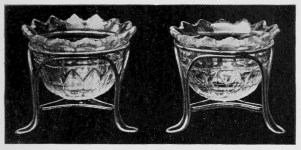
18th CENTURY CUT SWEETMEAT GLASSES IN OLD SHEFFIELD PLATED STANDS.
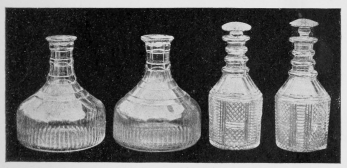
18th CENTURY DECANTERS, SHEWING VARIETY OF DESIGNS IN CUTTING.
FIG. 14.
the holder182 that he was at home, or to hint that he might think of going there, probably depended upon circumstances.
Other sets of decanters with engraved festoons and similar decorations of the same period are equally graceful both in design and execution. The stoppers are flat pear-shaped drops, and are doubtless of the Adam period. Another feature is their long, thin necks, which made them more suitable for private houses than inns. They usually stand from 12 to 18 inches in height, and when standing grouped together have a charmingly graceful appearance. They are rarely now to be found in fours, and it is doubtful if they were so made. I have only seen them in pairs. They are not particularly rare, many small houses possessing specimens.
It was at this period also that finger bowls came into fashion. The first ones made in this country were probably copies of old Roman coloured bowls. The earliest of all had two lips, used either for pouring out the contents or for resting a spoon upon. These specimens are, as a rule, exquisite183 both in style and shape, and it is, fortunately, within the power of the ordinary collector to acquire a specimen or so at{92} a reasonable figure. They are the larger and more ornamental184 pieces, some unique in design and others possessing historical associations, that are priceless. The old chandeliers often found will give some idea of the fine cutting of the period. The magnificent pear-drop-shaped lustres, the fine work on the stem, and the cross-over chains are characteristic of the lavish109 ornament of the age. Such have often been converted into pendants for electric light. Although no ordinary collector may hope to acquire them, they are not without interest as examples of a bygone fashion.
Through the kindness of Miss Whitmore Jones, I am enabled to reproduce from her beautiful collection at Chastleton House the posset pot shown at page 42 (Fig. 2). It is surrounded by a band of masks and roses and surmounted185 by a crown. It is an excellent example of the work of its period and one of the most admirable and beautiful specimens in existence.
Fig. 15 is an interesting illustration of the candlesticks and tapersticks formerly187 so widely used.
Tapersticks were used to hold the tapers186 used{93}
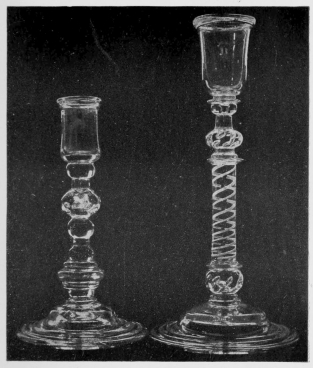
FIG. 15—CANDLE AND TAPER STICKS.
(From the Rees Price Collection, by permission of the Connoisseur.)
in sealing letters. That on the left is nearly perfect in style and ornamentation. Tapersticks are, of course, frequently found in Georgian silver and also in china, generally with the ink tray, snuffers, and powder box to hold the sand used in drying the writing. The glass tapersticks were generally about 7 or 8 in. in height and had domed feet.
The candlestick with the twisted stem—which, by the way, is of red drawn glass—is another fine specimen of the work of this period. Unluckily, examples are hardly likely to be very easily found; like all fragile things they have suffered heavily at the hands of Time. Fig. 16 is a representation of a very rare type of rush-light holder which dates from Jacobean times.
There is no doubt that the beauty and style of the Georgian glass, both early and late, have made it in great demand to-day, so that not only are enormous prices readily obtained for good specimens, but those prices are likely to be considerably188 enhanced in the future. Nevertheless, there are still many fine specimens to be obtained by a collector who will take the trouble to seek them off the beaten track. Many of them are owned by persons quite ignorant of their real{94} value; hence it is obvious that there is still sufficient scope for the collector of Georgian glass to acquire specimens which are not only pleasing in themselves but which are likely to bring him profit as well as pleasure.
It is only essential to emphasise94 once more the necessity of care; for glass, unlike china, has no marks by which its period and place of manufacture can be definitely determined189, and collectors can only base their opinions upon such qualities as shape, style, colour, etc., and in this, as in other departments of life, the amateur is apt to discover the truth of the adage190 that “a little knowledge is a dangerous thing.” It is best in any case of doubt to refer the question to some one who is in a position to speak with undoubted authority.
As to the Victorian Age, although it undoubtedly produced many fine specimens of glass, yet the pieces have little appeal from the collector’s point of view. Apart from this, however, it has many merits, some pieces that I have seen having been most beautifully and choicely cut and with a fine distinctive style. But, however choice, such pieces hardly fall within the category of Old English glass, and so lie beyond the scope of our inquiry191.{95}
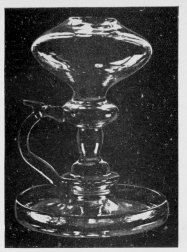
RARE JACOBEAN GLASS RUSH-LIGHT HOLDER.
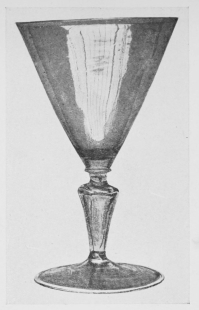
SPECIMEN OF AN EARLY ENGLISH WINE GLASS.
FIG. 16.

点击 收听单词发音
收听单词发音
 收听单词发音
收听单词发音
1
vessels

|
|
| n.血管( vessel的名词复数 );船;容器;(具有特殊品质或接受特殊品质的)人 | |
参考例句: |
|
|
|
2
ornament

|
|
| v.装饰,美化;n.装饰,装饰物 | |
参考例句: |
|
|
|
3
dome

|
|
| n.圆屋顶,拱顶 | |
参考例句: |
|
|
|
4
craftsmen

|
|
| n. 技工 | |
参考例句: |
|
|
|
5
steadily

|
|
| adv.稳定地;不变地;持续地 | |
参考例句: |
|
|
|
6
gleaned

|
|
| v.一点点地收集(资料、事实)( glean的过去式和过去分词 );(收割后)拾穗 | |
参考例句: |
|
|
|
7
haphazard

|
|
| adj.无计划的,随意的,杂乱无章的 | |
参考例句: |
|
|
|
8
tapestries

|
|
| n.挂毯( tapestry的名词复数 );绣帷,织锦v.用挂毯(或绣帷)装饰( tapestry的第三人称单数 ) | |
参考例句: |
|
|
|
9
mosaics

|
|
| n.马赛克( mosaic的名词复数 );镶嵌;镶嵌工艺;镶嵌图案 | |
参考例句: |
|
|
|
10
specimen

|
|
| n.样本,标本 | |
参考例句: |
|
|
|
11
dubious

|
|
| adj.怀疑的,无把握的;有问题的,靠不住的 | |
参考例句: |
|
|
|
12
authentic

|
|
| a.真的,真正的;可靠的,可信的,有根据的 | |
参考例句: |
|
|
|
13
authenticity

|
|
| n.真实性 | |
参考例句: |
|
|
|
14
excellences

|
|
| n.卓越( excellence的名词复数 );(只用于所修饰的名词后)杰出的;卓越的;出类拔萃的 | |
参考例句: |
|
|
|
15
profusion

|
|
| n.挥霍;丰富 | |
参考例句: |
|
|
|
16
fusion

|
|
| n.溶化;熔解;熔化状态,熔和;熔接 | |
参考例句: |
|
|
|
17
forefathers

|
|
| n.祖先,先人;祖先,祖宗( forefather的名词复数 );列祖列宗;前人 | |
参考例句: |
|
|
|
18
convivial

|
|
| adj.狂欢的,欢乐的 | |
参考例句: |
|
|
|
19
amenities

|
|
| n.令人愉快的事物;礼仪;礼节;便利设施;礼仪( amenity的名词复数 );便利设施;(环境等的)舒适;(性情等的)愉快 | |
参考例句: |
|
|
|
20
testimony

|
|
| n.证词;见证,证明 | |
参考例句: |
|
|
|
21
ingenuity

|
|
| n.别出心裁;善于发明创造 | |
参考例句: |
|
|
|
22
makers

|
|
| n.制造者,制造商(maker的复数形式) | |
参考例句: |
|
|
|
23
rinsed

|
|
| v.漂洗( rinse的过去式和过去分词 );冲洗;用清水漂洗掉(肥皂泡等);(用清水)冲掉 | |
参考例句: |
|
|
|
24
fig

|
|
| n.无花果(树) | |
参考例句: |
|
|
|
25
lighter

|
|
| n.打火机,点火器;驳船;v.用驳船运送;light的比较级 | |
参考例句: |
|
|
|
26
drawn

|
|
| v.拖,拉,拔出;adj.憔悴的,紧张的 | |
参考例句: |
|
|
|
27
opaque

|
|
| adj.不透光的;不反光的,不传导的;晦涩的 | |
参考例句: |
|
|
|
28
remarkable

|
|
| adj.显著的,异常的,非凡的,值得注意的 | |
参考例句: |
|
|
|
29
lustre

|
|
| n.光亮,光泽;荣誉 | |
参考例句: |
|
|
|
30
texture

|
|
| n.(织物)质地;(材料)构造;结构;肌理 | |
参考例句: |
|
|
|
31
artistic

|
|
| adj.艺术(家)的,美术(家)的;善于艺术创作的 | |
参考例句: |
|
|
|
32
originality

|
|
| n.创造力,独创性;新颖 | |
参考例句: |
|
|
|
33
meticulous

|
|
| adj.极其仔细的,一丝不苟的 | |
参考例句: |
|
|
|
34
compensated

|
|
| 补偿,报酬( compensate的过去式和过去分词 ); 给(某人)赔偿(或赔款) | |
参考例句: |
|
|
|
35
fully

|
|
| adv.完全地,全部地,彻底地;充分地 | |
参考例句: |
|
|
|
36
ornamented

|
|
| adj.花式字体的v.装饰,点缀,美化( ornament的过去式和过去分词 ) | |
参考例句: |
|
|
|
37
distinctive

|
|
| adj.特别的,有特色的,与众不同的 | |
参考例句: |
|
|
|
38
peril

|
|
| n.(严重的)危险;危险的事物 | |
参考例句: |
|
|
|
39
pervasive

|
|
| adj.普遍的;遍布的,(到处)弥漫的;渗透性的 | |
参考例句: |
|
|
|
40
plausible

|
|
| adj.似真实的,似乎有理的,似乎可信的 | |
参考例句: |
|
|
|
41
tint

|
|
| n.淡色,浅色;染发剂;vt.着以淡淡的颜色 | |
参考例句: |
|
|
|
42
enumerated

|
|
| v.列举,枚举,数( enumerate的过去式和过去分词 ) | |
参考例句: |
|
|
|
43
flanged

|
|
| 带凸缘的,用法兰连接的,折边的 | |
参考例句: |
|
|
|
44
ribs

|
|
| n.肋骨( rib的名词复数 );(船或屋顶等的)肋拱;肋骨状的东西;(织物的)凸条花纹 | |
参考例句: |
|
|
|
45
fixed

|
|
| adj.固定的,不变的,准备好的;(计算机)固定的 | |
参考例句: |
|
|
|
46
entirely

|
|
| ad.全部地,完整地;完全地,彻底地 | |
参考例句: |
|
|
|
47
bent

|
|
| n.爱好,癖好;adj.弯的;决心的,一心的 | |
参考例句: |
|
|
|
48
lessening

|
|
| 减轻,减少,变小 | |
参考例句: |
|
|
|
49
connoisseur

|
|
| n.鉴赏家,行家,内行 | |
参考例句: |
|
|
|
50
elongated

|
|
| v.延长,加长( elongate的过去式和过去分词 ) | |
参考例句: |
|
|
|
51
plunged

|
|
| v.颠簸( plunge的过去式和过去分词 );暴跌;骤降;突降 | |
参考例句: |
|
|
|
52
entangled

|
|
| adj.卷入的;陷入的;被缠住的;缠在一起的v.使某人(某物/自己)缠绕,纠缠于(某物中),使某人(自己)陷入(困难或复杂的环境中)( entangle的过去式和过去分词 ) | |
参考例句: |
|
|
|
53
meshes

|
|
| 网孔( mesh的名词复数 ); 网状物; 陷阱; 困境 | |
参考例句: |
|
|
|
54
decorative

|
|
| adj.装饰的,可作装饰的 | |
参考例句: |
|
|
|
55
engraved

|
|
| v.在(硬物)上雕刻(字,画等)( engrave的过去式和过去分词 );将某事物深深印在(记忆或头脑中) | |
参考例句: |
|
|
|
56
petals

|
|
| n.花瓣( petal的名词复数 ) | |
参考例句: |
|
|
|
57
specially

|
|
| adv.特定地;特殊地;明确地 | |
参考例句: |
|
|
|
58
adoption

|
|
| n.采用,采纳,通过;收养 | |
参考例句: |
|
|
|
59
previously

|
|
| adv.以前,先前(地) | |
参考例句: |
|
|
|
60
illustrate

|
|
| v.举例说明,阐明;图解,加插图 | |
参考例句: |
|
|
|
61
bulge

|
|
| n.突出,膨胀,激增;vt.突出,膨胀 | |
参考例句: |
|
|
|
62
bulges

|
|
| 膨胀( bulge的名词复数 ); 鼓起; (身体的)肥胖部位; 暂时的激增 | |
参考例句: |
|
|
|
63
technically

|
|
| adv.专门地,技术上地 | |
参考例句: |
|
|
|
64
domed

|
|
| adj. 圆屋顶的, 半球形的, 拱曲的 动词dome的过去式和过去分词形式 | |
参考例句: |
|
|
|
65
judiciously

|
|
| adv.明断地,明智而审慎地 | |
参考例句: |
|
|
|
66
infinity

|
|
| n.无限,无穷,大量 | |
参考例句: |
|
|
|
67
yarn

|
|
| n.纱,纱线,纺线;奇闻漫谈,旅行轶事 | |
参考例句: |
|
|
|
68
peculiar

|
|
| adj.古怪的,异常的;特殊的,特有的 | |
参考例句: |
|
|
|
69
supplanted

|
|
| 把…排挤掉,取代( supplant的过去式和过去分词 ) | |
参考例句: |
|
|
|
70
graceful

|
|
| adj.优美的,优雅的;得体的 | |
参考例句: |
|
|
|
71
ware

|
|
| n.(常用复数)商品,货物 | |
参考例句: |
|
|
|
72
abrupt

|
|
| adj.突然的,意外的;唐突的,鲁莽的 | |
参考例句: |
|
|
|
73
monogram

|
|
| n.字母组合 | |
参考例句: |
|
|
|
74
specimens

|
|
| n.样品( specimen的名词复数 );范例;(化验的)抽样;某种类型的人 | |
参考例句: |
|
|
|
75
circumference

|
|
| n.圆周,周长,圆周线 | |
参考例句: |
|
|
|
76
regularity

|
|
| n.规律性,规则性;匀称,整齐 | |
参考例句: |
|
|
|
77
binding

|
|
| 有约束力的,有效的,应遵守的 | |
参考例句: |
|
|
|
78
softened

|
|
| (使)变软( soften的过去式和过去分词 ); 缓解打击; 缓和; 安慰 | |
参考例句: |
|
|
|
79
simplicity

|
|
| n.简单,简易;朴素;直率,单纯 | |
参考例句: |
|
|
|
80
sufficiently

|
|
| adv.足够地,充分地 | |
参考例句: |
|
|
|
81
scrutiny

|
|
| n.详细检查,仔细观察 | |
参考例句: |
|
|
|
82
judgment

|
|
| n.审判;判断力,识别力,看法,意见 | |
参考例句: |
|
|
|
83
opacity

|
|
| n.不透明;难懂 | |
参考例句: |
|
|
|
84
criteria

|
|
| n.标准 | |
参考例句: |
|
|
|
85
forgeries

|
|
| 伪造( forgery的名词复数 ); 伪造的文件、签名等 | |
参考例句: |
|
|
|
86
mellow

|
|
| adj.柔和的;熟透的;v.变柔和;(使)成熟 | |
参考例句: |
|
|
|
87
tinge

|
|
| vt.(较淡)着色于,染色;使带有…气息;n.淡淡色彩,些微的气息 | |
参考例句: |
|
|
|
88
translucent

|
|
| adj.半透明的;透明的 | |
参考例句: |
|
|
|
89
perfectly

|
|
| adv.完美地,无可非议地,彻底地 | |
参考例句: |
|
|
|
90
descends

|
|
| v.下来( descend的第三人称单数 );下去;下降;下斜 | |
参考例句: |
|
|
|
91
junction

|
|
| n.连接,接合;交叉点,接合处,枢纽站 | |
参考例句: |
|
|
|
92
downwards

|
|
| adj./adv.向下的(地),下行的(地) | |
参考例句: |
|
|
|
93
unduly

|
|
| adv.过度地,不适当地 | |
参考例句: |
|
|
|
94
emphasise

|
|
| vt.加强...的语气,强调,着重 | |
参考例句: |
|
|
|
95
undoubtedly

|
|
| adv.确实地,无疑地 | |
参考例句: |
|
|
|
96
hovering

|
|
| 鸟( hover的现在分词 ); 靠近(某事物); (人)徘徊; 犹豫 | |
参考例句: |
|
|
|
97
degenerates

|
|
| 衰退,堕落,退化( degenerate的第三人称单数 ) | |
参考例句: |
|
|
|
98
moth

|
|
| n.蛾,蛀虫 | |
参考例句: |
|
|
|
99
truncated

|
|
| adj.切去顶端的,缩短了的,被删节的v.截面的( truncate的过去式和过去分词 );截头的;缩短了的;截去顶端或末端 | |
参考例句: |
|
|
|
100
cone

|
|
| n.圆锥体,圆锥形东西,球果 | |
参考例句: |
|
|
|
101
attained

|
|
| (通常经过努力)实现( attain的过去式和过去分词 ); 达到; 获得; 达到(某年龄、水平、状况) | |
参考例句: |
|
|
|
102
tavern

|
|
| n.小旅馆,客栈;小酒店 | |
参考例句: |
|
|
|
103
worthy

|
|
| adj.(of)值得的,配得上的;有价值的 | |
参考例句: |
|
|
|
104
entrusted

|
|
| v.委托,托付( entrust的过去式和过去分词 ) | |
参考例句: |
|
|
|
105
flute

|
|
| n.长笛;v.吹笛 | |
参考例句: |
|
|
|
106
fluted

|
|
| a.有凹槽的 | |
参考例句: |
|
|
|
107
continental

|
|
| adj.大陆的,大陆性的,欧洲大陆的 | |
参考例句: |
|
|
|
108
lavishness

|
|
| n.浪费,过度 | |
参考例句: |
|
|
|
|
109
lavish

|
|
| adj.无节制的;浪费的;vt.慷慨地给予,挥霍 | |
参考例句: |
|
|
|
110
flutes

|
|
| 长笛( flute的名词复数 ); 细长香槟杯(形似长笛) | |
参考例句: |
|
|
|
111
merged

|
|
| (使)混合( merge的过去式和过去分词 ); 相融; 融入; 渐渐消失在某物中 | |
参考例句: |
|
|
|
112
bumpers

|
|
| (汽车上的)保险杠,缓冲器( bumper的名词复数 ) | |
参考例句: |
|
|
|
113
champagne

|
|
| n.香槟酒;微黄色 | |
参考例句: |
|
|
|
114
Vogue

|
|
| n.时髦,时尚;adj.流行的 | |
参考例句: |
|
|
|
115
beverages

|
|
| n.饮料( beverage的名词复数 ) | |
参考例句: |
|
|
|
116
adorned

|
|
| [计]被修饰的 | |
参考例句: |
|
|
|
117
adorn

|
|
| vt.使美化,装饰 | |
参考例句: |
|
|
|
118
barley

|
|
| n.大麦,大麦粒 | |
参考例句: |
|
|
|
119
hops

|
|
| 跳上[下]( hop的第三人称单数 ); 单足蹦跳; 齐足(或双足)跳行; 摘葎草花 | |
参考例句: |
|
|
|
120
forth

|
|
| adv.向前;向外,往外 | |
参考例句: |
|
|
|
121
varied

|
|
| adj.多样的,多变化的 | |
参考例句: |
|
|
|
122
faceted

|
|
| adj. 有小面的,分成块面的 | |
参考例句: |
|
|
|
123
facets

|
|
| n.(宝石或首饰的)小平面( facet的名词复数 );(事物的)面;方面 | |
参考例句: |
|
|
|
124
unearths

|
|
| 发掘或挖出某物( unearth的第三人称单数 ); 搜寻到某事物,发现并披露 | |
参考例句: |
|
|
|
|
125
esteem

|
|
| n.尊敬,尊重;vt.尊重,敬重;把…看作 | |
参考例句: |
|
|
|
126
allied

|
|
| adj.协约国的;同盟国的 | |
参考例句: |
|
|
|
127
rim

|
|
| n.(圆物的)边,轮缘;边界 | |
参考例句: |
|
|
|
128
standing

|
|
| n.持续,地位;adj.永久的,不动的,直立的,不流动的 | |
参考例句: |
|
|
|
129
chronological

|
|
| adj.按年月顺序排列的,年代学的 | |
参考例句: |
|
|
|
130
mead

|
|
| n.蜂蜜酒 | |
参考例句: |
|
|
|
131
inscribed

|
|
| v.写,刻( inscribe的过去式和过去分词 );内接 | |
参考例句: |
|
|
|
132
excise

|
|
| n.(国产)货物税;vt.切除,删去 | |
参考例句: |
|
|
|
133
earthenware

|
|
| n.土器,陶器 | |
参考例句: |
|
|
|
134
distinctively

|
|
| adv.特殊地,区别地 | |
参考例句: |
|
|
|
135
awesome

|
|
| adj.令人惊叹的,难得吓人的,很好的 | |
参考例句: |
|
|
|
136
brew

|
|
| v.酿造,调制 | |
参考例句: |
|
|
|
137
pungent

|
|
| adj.(气味、味道)刺激性的,辛辣的;尖锐的 | |
参考例句: |
|
|
|
138
aromatic

|
|
| adj.芳香的,有香味的 | |
参考例句: |
|
|
|
139
clamorous

|
|
| adj.吵闹的,喧哗的 | |
参考例句: |
|
|
|
140
ferment

|
|
| vt.使发酵;n./vt.(使)激动,(使)动乱 | |
参考例句: |
|
|
|
141
starch

|
|
| n.淀粉;vt.给...上浆 | |
参考例句: |
|
|
|
142
flaring

|
|
| a.火焰摇曳的,过份艳丽的 | |
参考例句: |
|
|
|
143
distillation

|
|
| n.蒸馏,蒸馏法 | |
参考例句: |
|
|
|
144
distilled

|
|
| adj.由蒸馏得来的v.蒸馏( distil的过去式和过去分词 );从…提取精华 | |
参考例句: |
|
|
|
145
syrups

|
|
| n.糖浆,糖汁( syrup的名词复数 );糖浆类药品 | |
参考例句: |
|
|
|
146
quaint

|
|
| adj.古雅的,离奇有趣的,奇怪的 | |
参考例句: |
|
|
|
147
quotation

|
|
| n.引文,引语,语录;报价,牌价,行情 | |
参考例句: |
|
|
|
148
intensified

|
|
| v.(使)增强, (使)加剧( intensify的过去式和过去分词 ) | |
参考例句: |
|
|
|
149
replicas

|
|
| n.复制品( replica的名词复数 ) | |
参考例句: |
|
|
|
150
affected

|
|
| adj.不自然的,假装的 | |
参考例句: |
|
|
|
151
prevailing

|
|
| adj.盛行的;占优势的;主要的 | |
参考例句: |
|
|
|
152
unison

|
|
| n.步调一致,行动一致 | |
参考例句: |
|
|
|
153
figs

|
|
| figures 数字,图形,外形 | |
参考例句: |
|
|
|
154
strictly

|
|
| adv.严厉地,严格地;严密地 | |
参考例句: |
|
|
|
155
utilitarian

|
|
| adj.实用的,功利的 | |
参考例句: |
|
|
|
156
emblem

|
|
| n.象征,标志;徽章 | |
参考例句: |
|
|
|
157
justification

|
|
| n.正当的理由;辩解的理由 | |
参考例句: |
|
|
|
158
utensils

|
|
| 器具,用具,器皿( utensil的名词复数 ); 器物 | |
参考例句: |
|
|
|
159
advent

|
|
| n.(重要事件等的)到来,来临 | |
参考例句: |
|
|
|
160
stoutness

|
|
| 坚固,刚毅 | |
参考例句: |
|
|
|
161
taper

|
|
| n.小蜡烛,尖细,渐弱;adj.尖细的;v.逐渐变小 | |
参考例句: |
|
|
|
162
profusely

|
|
| ad.abundantly | |
参考例句: |
|
|
|
163
engraving

|
|
| n.版画;雕刻(作品);雕刻艺术;镌版术v.在(硬物)上雕刻(字,画等)( engrave的现在分词 );将某事物深深印在(记忆或头脑中) | |
参考例句: |
|
|
|
164
Dispersive

|
|
| adj. 分散的 | |
参考例句: |
|
|
|
165
esteemed

|
|
| adj.受人尊敬的v.尊敬( esteem的过去式和过去分词 );敬重;认为;以为 | |
参考例句: |
|
|
|
166
spikes

|
|
| n.穗( spike的名词复数 );跑鞋;(防滑)鞋钉;尖状物v.加烈酒于( spike的第三人称单数 );偷偷地给某人的饮料加入(更多)酒精( 或药物);把尖状物钉入;打乱某人的计划 | |
参考例句: |
|
|
|
167
spiked

|
|
| adj.有穗的;成锥形的;有尖顶的 | |
参考例句: |
|
|
|
168
jingling

|
|
| 叮当声 | |
参考例句: |
|
|
|
169
dire

|
|
| adj.可怕的,悲惨的,阴惨的,极端的 | |
参考例句: |
|
|
|
170
upheaval

|
|
| n.胀起,(地壳)的隆起;剧变,动乱 | |
参考例句: |
|
|
|
171
momentous

|
|
| adj.重要的,重大的 | |
参考例句: |
|
|
|
172
monarch

|
|
| n.帝王,君主,最高统治者 | |
参考例句: |
|
|
|
173
severely

|
|
| adv.严格地;严厉地;非常恶劣地 | |
参考例句: |
|
|
|
174
porcelain

|
|
| n.瓷;adj.瓷的,瓷制的 | |
参考例句: |
|
|
|
175
machinery

|
|
| n.(总称)机械,机器;机构 | |
参考例句: |
|
|
|
176
scrupulous

|
|
| adj.审慎的,小心翼翼的,完全的,纯粹的 | |
参考例句: |
|
|
|
177
impurities

|
|
| 不纯( impurity的名词复数 ); 不洁; 淫秽; 杂质 | |
参考例句: |
|
|
|
178
isle

|
|
| n.小岛,岛 | |
参考例句: |
|
|
|
179
interfere

|
|
| v.(in)干涉,干预;(with)妨碍,打扰 | |
参考例句: |
|
|
|
180
overdone

|
|
| v.做得过分( overdo的过去分词 );太夸张;把…煮得太久;(工作等)过度 | |
参考例句: |
|
|
|
181
curiously

|
|
| adv.有求知欲地;好问地;奇特地 | |
参考例句: |
|
|
|
182
holder

|
|
| n.持有者,占有者;(台,架等)支持物 | |
参考例句: |
|
|
|
183
exquisite

|
|
| adj.精美的;敏锐的;剧烈的,感觉强烈的 | |
参考例句: |
|
|
|
184
ornamental

|
|
| adj.装饰的;作装饰用的;n.装饰品;观赏植物 | |
参考例句: |
|
|
|
185
surmounted

|
|
| 战胜( surmount的过去式和过去分词 ); 克服(困难); 居于…之上; 在…顶上 | |
参考例句: |
|
|
|
186
tapers

|
|
| (长形物体的)逐渐变窄( taper的名词复数 ); 微弱的光; 极细的蜡烛 | |
参考例句: |
|
|
|
187
formerly

|
|
| adv.从前,以前 | |
参考例句: |
|
|
|
188
considerably

|
|
| adv.极大地;相当大地;在很大程度上 | |
参考例句: |
|
|
|
189
determined

|
|
| adj.坚定的;有决心的 | |
参考例句: |
|
|
|
190
adage

|
|
| n.格言,古训 | |
参考例句: |
|
|
|
191
inquiry

|
|
| n.打听,询问,调查,查问 | |
参考例句: |
|
|
|
| 欢迎访问英文小说网 |

